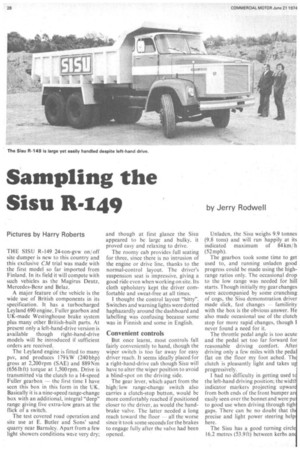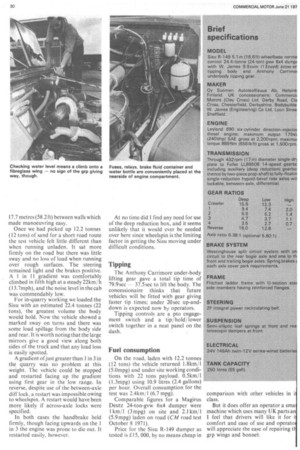Sampling the
Page 30

Page 32

If you've noticed an error in this article please click here to report it so we can fix it.
Sisu R-149 by Jerry Rodwell
Pictures by Harry Roberts
THE SISU R-I49 24-ton-gvw on/ off site dumper is new to this country and this exclusive CM trial was made with the first model so far imported from Finland. In its field it will compete with such vehicles as the Magirus Deutz, Mercedes-Benz and Belaz.
A major feature of the vehicle is the wide use of British components in its specification. It has a turbocharged Leyland 690 engine, Fuller gearbox and UK-made Westinghouse brake system plus many other British-built parts. At present only a left-hand-drive version is available though right-hand-drive models will be introduced if sufficient orders are received.
The Leyland engine is fitted to many psv, and produces 179 kW (240bhp) gross at 2,200 rpm (SAE) and 889 Nm (656 lb ft) torque at 1,500 rpm. Drive is transmitted via the clutch to a 14-speed Fuller gearbox — the first time I have seen this box in this form in the UK. Basically it is a nine-speed range-change box with an additional, integral "deep" range giving five extra-low gears at the flick of a switch.
The test covered road operation and site use at E. Butler and Sons sand quarry near Barnsley. Apart from a few light showers conditions we, e very dry; and though at first glance the Sisu appeared to be large and bulky, it proved easy and relaxing to drive.
The roomy cab provides full seating for three, since there is no intrusion of the engine or drive line, thanks to the normal-control layout. The driver's suspension seat is impressive, giving a good ride even when working on site. Its cloth upholstery kept the driver comfortable and sweat-free at all times.
I thought the control layout "bitty". Switches and warning lights were dotted haphazardly around the dashboard and labelling was confusing because some was in Finnish and some in English.
Convenient controls
But once learnt, most controls fall fairly conveniently to hand, though the wiper switch is too far away for easy driver reach. It seems ideally placed for a right-hand-drive cab though Sisu will have to alter the wiper position to avoid a blind-spot on the driving side.
The gear lever, which apart from the high/low range-change switch also carries a clutch-stop button, would be more comfortably reached if positioned closer to the driver, as would the handbrake valve. The latter needed a long reach toward the floor – all the worse since it took some seconds for the brakes to engage fully after the valve had been opened. Unladen, the Sisu weighs 9.9 tonnes (9.8 tons) and will run happily at its indicated maximum of 84 km/ h (52 mph).
The gearbox took some time to get used to, and running unladen good progress could be made using the highrange ratios only. The occasional drop to the low range was needed for hill starts. Though initially my gear changes were accompanied by some crunching of cogs, the Sisu demonstration driver made slick, fast changes -familirity with the box is the obvious answer. He also made occasional use of the clutch stop for more rapid changes, though I never found a need for it.
The throttle pedal angle is too acute and the pedal set too far forward for reasonable driving comfort. Afte driving only a few miles with the peda flat on the floor my foot ached. Th• clutch is pleasantly light and takes u progressively.
I had no difficulty in. getting used t the left-hand driving position; the widt indicator markers projecting upwar from both ends of the front bumper an easily seen over the bonnet and were pu to good use when driving through tigh gaps. There can be no doubt that th precise and light power steering help here.
The Sisu has a good turning circl 16.2 metres (53.9ft) between kerbs an 17.7 metres (58.2 ft) between walls which made manoeuvring easy.
Once we had picked up 12.2 tonnes (12 tons) of sand for a short road route the test vehicle felt little different than when running unladen. It sat more firmly on the road but there was little sway and no loss of load when running over rough surfaces. The steering remained light and the brakes positive.
A I in 11 gradient was comfortably climbed in fifth high at a steady 22km/ h (13.7mph), and the noise level in the cab was commendably low.
For in-quarry working we loaded the Sisu with an estimated 22.4 tonnes (22 tons), the greatest volume the body would hold. Now the vehicle showed a marked sway on turns and there was some load spillage from the body side and rear. It is worth noting that the large mirrors give a good view along both sides of the truck and that any load loss is easily spotted.
A gradient of just greater than 1 in 3 in the quarry was no problem at this weight. The vehicle could be stopped and restarted facing up the gradient using first gear in the low range. In reverse, despite use of the between-axle diff lock, a restart was impossible owing to wheelspin. A restart would have been more likely if across-axle locks were specified.
In both cases the handbrake held firmly, though facing upwards on the 1 in 3 the engine was prone to die out. It restarted easily, however. At no time did [find any need for use of the deep reduction box, and it seems unlikely that it would ever be needed over here since wheelspin is the limiting factor in getting the Sisu moving under difficult conditions.
Tipping
The Anthony Carrimore under-body lifting gear gave a total tip time of 79.9 sec 37.5sec to lift the body. The concessionaire thinks that future vehicles will be fitted with gear giving faster tip times; under 20 see up-anddown is expected now by operators.
Tipping controls are a pto engagement switch and a tip/ hold/ lower switch together in a neat panel on the dash.
Fuel consumption
On the road, laden with 12.2 tonnes (12 tons) the vehicle returned 1.8km/ I (5.0mpg) and under site working conditions with 22 tons payload. 0.5km/1 (1.3mpg) using 10.9 litres (2.4 gallons) per hour. Overall consumption for the test was 2.4kmi 1 (6.7 mpg).
Comparable figures for a Magirus Deutz 24-ton-gvw 6x4 dumper were 1 km/1 (3 mpg) on site and 2.1km/1 (5.9 mpg) laden on road (CM road test October 8 1971).
Price for the Sisu R-149 dumper as tested is £1 5, 000, by no means cheap in comparison with other vehicles in class.
But it does offer an operator a sma machine which uses many UK parts an I feel that drivers will like it for i comfort and ease of use and operato will appreciate the ease of repairing t grp wings and bonne.








































































































